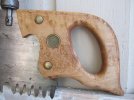Here's a photo of my makeshift saw vise. I'd love to have a real one but it just isn't practical for me to give up that much shop space for something I'm only going to use maybe once a year. So I just ripped a block of wood in half at a 25° angle and hot melt glued the halves to the jaws of my vise. Then I propped up the loose end of the saw with a runoff stand. It works OK but I have to keep repositioning the saw to keep the work close to the jaws. I tried 15° blocks first and that wasn't nearly enough tilt. 25° was OK but I might try 30° or even 35° next time.
Here are some freshly sharpened teeth. The teeth facing the other way still have their flat spots from the jointing process.
This saw needed some serious jointing. It took me over 5 hours to go through the whole sharpening process on this 48" saw. I hate to think how long my 90" will take. I've still got the saw apart for refinishing the handle but I'll post another pic once it's finished and put back together. It cuts like a dream right now. Helluva lotta work but worth it.








